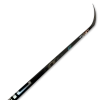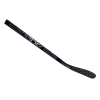If you're a hockey player, you probably know that your stick flex is an important factor in your performance. But do you know how your stick flex changes as you cut down your stick to fit your height and preference? Below, we’ll explain the basics of stick flex and how it affects your shot, and how to adjust your flex when you cut your stick.
The basics
Stick flex is a measure of how much force it takes to bend your stick one inch. The higher the flex number, the stiffer the stick. The lower the flex number, the more flexible the stick. Stick flex affects how much power and accuracy you can generate in your shot, as well as how much feel and control you have over the puck.
In general, a stiffer stick will give you more power and accuracy, but less feel and control. A more flexible stick will give you more feel and control, but less power and accuracy. The optimal stick flex for you depends on your personal preference, shooting style, strength, and skill level.
Every stick is manufactured to a certain flex given its overall length and kick point characteristics. While this number technically doesn’t change as you cut a stick down (It just moves it up the shaft toward the butt end,) the reality is that a hockey stick behaves just like a piece of wood. The shorter you cut it, the more force it will take to bend the stick that same 1”, thus making it stiffer. So, while the manufacturer flex doesn’t change on this stick, it will take the force of a stiffer flex to make the stick work correctly. For example, if you have a 100-flex stick senior stick that is 60 inches long, and you cut it down to 57 inches, your flex will increase to roughly 110.
This means that if you want to maintain the same flex as before, you need to buy a lower flex stick before cutting it down. For example, if you want a 100-flex stick after cutting it down to 57 inches, you need to buy an 85-ish flex stick and cut it down.

It's not the same for every stick
It’s important to note, though, that this isn’t a firm measurement. It changes depending on the stick size and build. The more you move down the shaft to cut it off, the more stiff the stick will become for each inch removed. For instance, cutting an inch or two off a senior stick won’t result in much of a difference in stiffness; likely not even 5 flex total. The next inch or two off it will shorten the stick much more though and will create a much more noticeable difference; about 10-15 flex more. This scale is much more dramatic on intermediate and junior sticks since they are manufactured shorter to begin with.
You can always make changes in your shooting technique to adapt to the higher flex rather than buying a new stick. For example, you can lean more into your shots, use more wrist action, or change your hand position.
The bottom line is that, while a manufacturer flex number doesn’t change, cutting down your stick affects your stick stiffness and feeling of flex, and you need to be aware of that when choosing and using your stick. Stick flex is a personal preference, but it also affects your performance on the ice. By understanding how stick flex works and how it changes as you cut down your stick, you can optimize your shot and improve your game.
If you want more information on stick flex, be sure to check out the rest of our blog and one of the most popular articles we’ve written.





